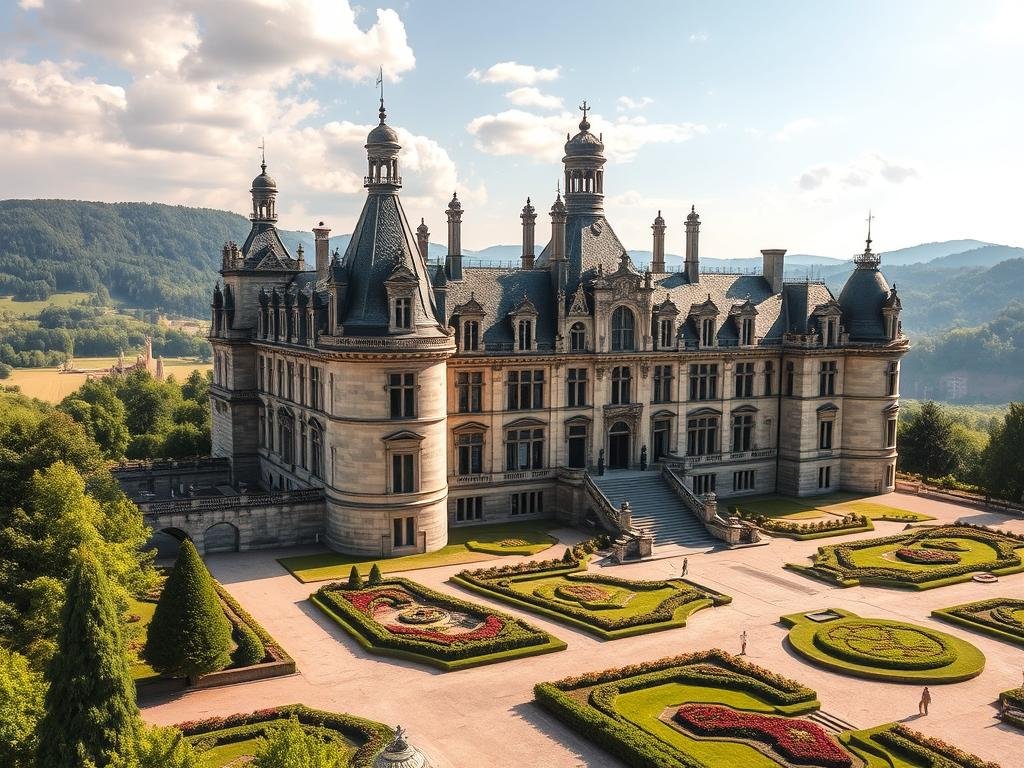Nestled in the scenic landscape of the Dordogne region, Château de Hautefort stands as a masterpiece of French architecture
This grand castle, renowned for its refined facades and ornate detailing, invites visitors to explore its rich history and spectacular surroundings
From its elevated position, it offers breathtaking views, serving not only as a historical gem but also a beacon of cultural heritage
The castle features an impressive 17th-century facade and formal gardens designed by André Le Nôtre, the landscape architect famous for the Palace of Versailles1
The serene and picturesque settings of the Château de Hautefort invite reflective exploration, making it an ideal destination for those who seek both beauty and history in their travels1
As part of the Dordogne region, famed for its historical wonders including majestic castles, the Château de Hautefort stands out as a prominent landmark1
Expert guides provide personalized attention during small group tours, ensuring visitors can delve deeper into the rich history of the area1
Key Takeaways
- Château de Hautefort is a prestigious French castle in the scenic Dordogne region.
- Renowned for its 17th-century facade and formal gardens by André Le Nôtre.
- The castle offers serene and picturesque settings for visitors to explore.
- It is a significant historical monument and a vital part of French heritage.
- Expert guides offer personalized tours to delve deeper into its rich history.
History of Château de Hautefort
The historic French castle, Château de Hautefort, represents a significant chapter in French heritage. Nestled within the Dordogne region, this château exudes a timeless charm that encapsulates both its storied past and architectural elegance.
Origins and Early Architecture
Tracing back to the 17th century, Château de Hautefort began its transformation from a medieval fortress to a leisure manor during this period. With its central castle built between 1630 and 1670, the structure deftly blends medieval defensive features with classical design elements2. The resulting architecture stands as a testament to the château’s evolution, reflecting the aesthetic and functional imperatives of this transformative era.
Notably, the château’s gardens—an English-style park and French-style gardens—were designed by the Count of Choulot in the 19th century2.
Key Historical Events
Throughout its history, Château de Hautefort has witnessed numerous pivotal events. From its strategic location, 28 km north of Montignac and the famed Lascaux caves2, it has played a role in the broader historical narrative of the region. The châteaux of the Dordogne, including Hautefort, stand as enduring symbols of past grandeur and splendor3.
“Château de Hautefort is a dazzling example of Renaissance architecture surrounded by formal gardens,”
praised for both its historical significance and its remarkable collection of 17th and 18th-century period furniture2.
Restoration Efforts
The architectural restoration efforts at Château de Hautefort are a dedicated pursuit to preserve its artistic heritage. In recent years, extensive work has been carried out to maintain the château’s structure and aesthetics, ensuring it remains a paragon of historical resilience. Such endeavors underscore the château’s importance as a vibrant piece of Château de Hautefort history, continuing to captivate visitors and art enthusiasts alike.
Today, the château’s expansive estate, with its network of hiking trails, provides a captivating exploration of both its natural beauty and architectural grandeur2. These trails, ranging from 2.6 km to 12.4 km in distance, offer varied experiences that further enhance the château’s allure2.
Architectural Features
Château de Hautefort stands as an architectural gem that elegantly showcases the classical aesthetic of the 17th century redesign, reflecting the ideals of symmetry, proportion, and grandeur4. Its distinctive design elements are manifested through the harmonious blend of Renaissance refinement and striking structural beauty.
Distinctive Design Elements
Visitors are captivated by the château’s intricate stonework and towering turrets, reminiscent of the region’s Renaissance heritage4. The thoughtful use of local materials and traditional building techniques ensures that the Château de Hautefort design remains timeless, striking a balance between historical reverence and aesthetic allure4.
Gardens and Landscaping
The expansive gardens and landscaping of Château de Hautefort offer a serene escape, enveloping the château in natural beauty5. These meticulously maintained gardens, featuring geometric flowerbeds and clipped hedges, not only add to the château’s allure but also provide stunning views of the picturesque Dordogne countryside5. The design of these gardens epitomizes the elegant, structured approach seen in French formal gardens, creating a seamless connection between architecture and nature.
Interior Highlights
Beyond the exterior, the interior of Château de Hautefort is equally impressive and reflects a long history of elegance and opulence. Each of the approximately 20 rooms available for exploration features elaborate decorations, including 17th-century baroque elements and original décor5. Highlights such as the Tapestry Room, adorned with 16th-century Flemish and Brussels tapestries, and the State Bedroom with its antique French ceremonial bed, offer a glimpse into the château’s richly decorated past5.
Visiting Château de Hautefort
Nestled in the enchanting Dordogne region, the Château de Hautefort combines historical grandeur with modern convenience. Easily accessible from major routes, this top tourist attraction beckons all who wish to immerse themselves in French history and scenic beauty. Whether you plan to visit Hautefort Castle for its architectural splendor or its lush gardens, the journey promises to be rewarding.
Location and Accessibility
The Château de Hautefort is situated in the picturesque Dordogne region, known for its rich historical significance and stunning landscapes. Access to the château is conveniently routed through well-maintained roads, making it an easily reachable destination for tourists. The château boasts ample parking and clear signage, ensuring a smooth journey for all visitors6. For those interested in the cultural significance of the region, the Château de Hautefort accessibility is a key feature, providing visitors with the opportunity to explore this magnificent site without hassle.
Nearby Attractions
Exploring the Dordogne region around the Château de Hautefort unveils a host of nearby attractions that further enrich the visitor experience. Popular sites include the scenic Auvézère gorges where hiking trails abound, offering breathtaking views and invigorating outdoor activities. Family-friendly activities extend to the forges of Savignac-Lédrier, where history and craftsmanship come alive. Incorporating these nearby attractions into your itinerary ensures a comprehensive and memorable visit to one of France’s most charming areas67.
Events and Festivities
The Château de Hautefort is a vibrant focal point for a plethora of events and festivities throughout the year. Among the many Château de Hautefort events, the annual festivals stand out as a highlight, drawing visitors from near and far to celebrate the local culture and rich historical heritage of the Dordogne region.
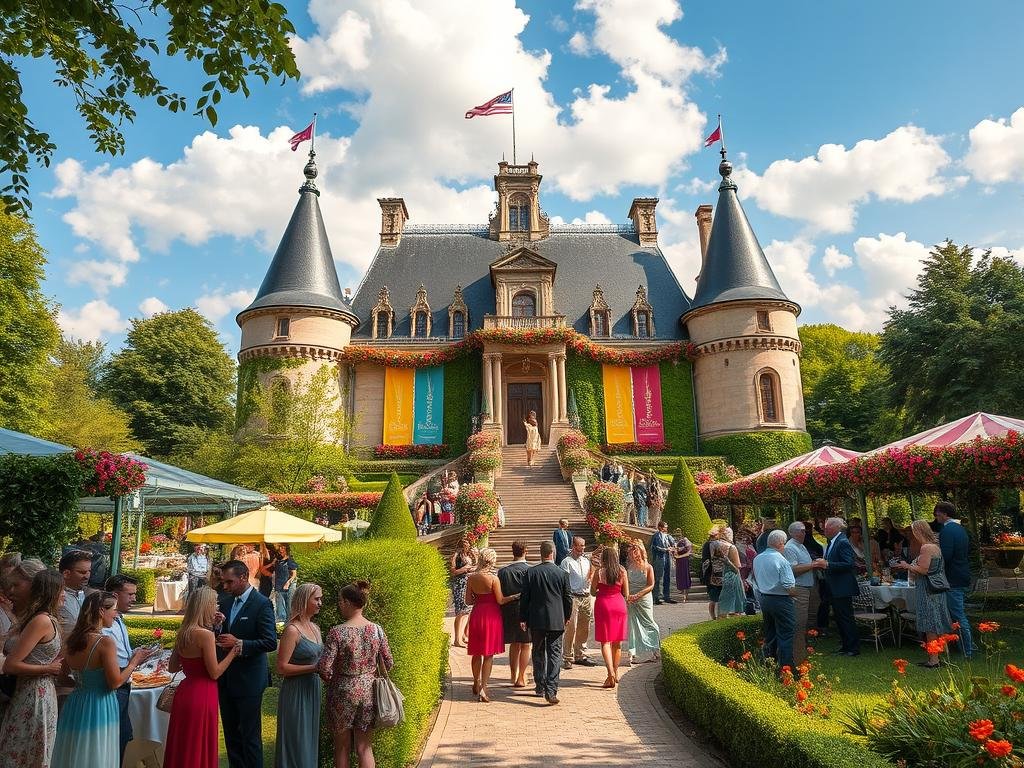
Annual Festivals
Each year, visitors can partake in various annual festivals that showcase the spirit and traditions of the area. These events offer a unique opportunity to delve into the diverse cultural experiences of the Périgord Noir region8. From music festivals to historical reenactments, there is always something to captivate every visitor’s interest. The summer season, in particular, is bustling with festivals that attract numerous attendees9.
Private Events and Weddings
The château serves as an enchanting backdrop for private events and weddings, making every occasion as unforgettable as the setting. Weddings at Hautefort are renowned for their fairy-tale ambiance, with customized experiences designed to match the couple’s vision. Many castles within the Dordogne region, including Château de Hautefort, offer immersive guided tours and specialized events to engage visitors in the area’s rich history and culture8. For those seeking a touch of romance and elegance, hosting a wedding or private event at this iconic location is an unparalleled choice.
Tips for Tourists
Nestled in the picturesque Dordogne region, the Château de Hautefort is a gem of historical and architectural beauty. For those planning a visit, timing and tour recommendations can greatly enhance the experience.
Best Times to Visit
To fully appreciate the splendor of Château de Hautefort, the best times to visit Hautefort are during the late spring and early autumn months, specifically from April to June and September to October. These seasons highlight the natural and architectural beauty with mild weather and fewer tourists compared to the bustling summer months10. The Dordogne region, being the third largest area in France, offers ample opportunities for exploration during these serene periods10.
Recommended Tours
For an enriching experience, consider opting for recommended tours that provide insightful narratives about the château’s past and present. Tour services in the Dordogne region often offer tailored itineraries, language assistance, and activity suggestions to enhance your visit11. With over 200 different activities and places of interest in the region, having a well-planned itinerary can make all the difference11.
Utilizing these recommendations and tips ensures that your visit to the Château de Hautefort is both memorable and immersive, allowing you to capture the essence of this historic location.
Culinary Delights
The region surrounding Château de Hautefort is a paradise for food enthusiasts, offering an array of culinary delights that promise an unforgettable gastronomic journey through local heritage.
Dining Options Nearby
Exploring dining near Château de Hautefort reveals a treasure trove of delightful eateries. From rustic bistros that encapsulate the essence of local French cuisine to elegant restaurants that provide a refined dining experience, there is something to satisfy every palate. Dining in this region is more than just a meal; it’s an excursion into the culinary traditions that have shaped French culture for centuries.
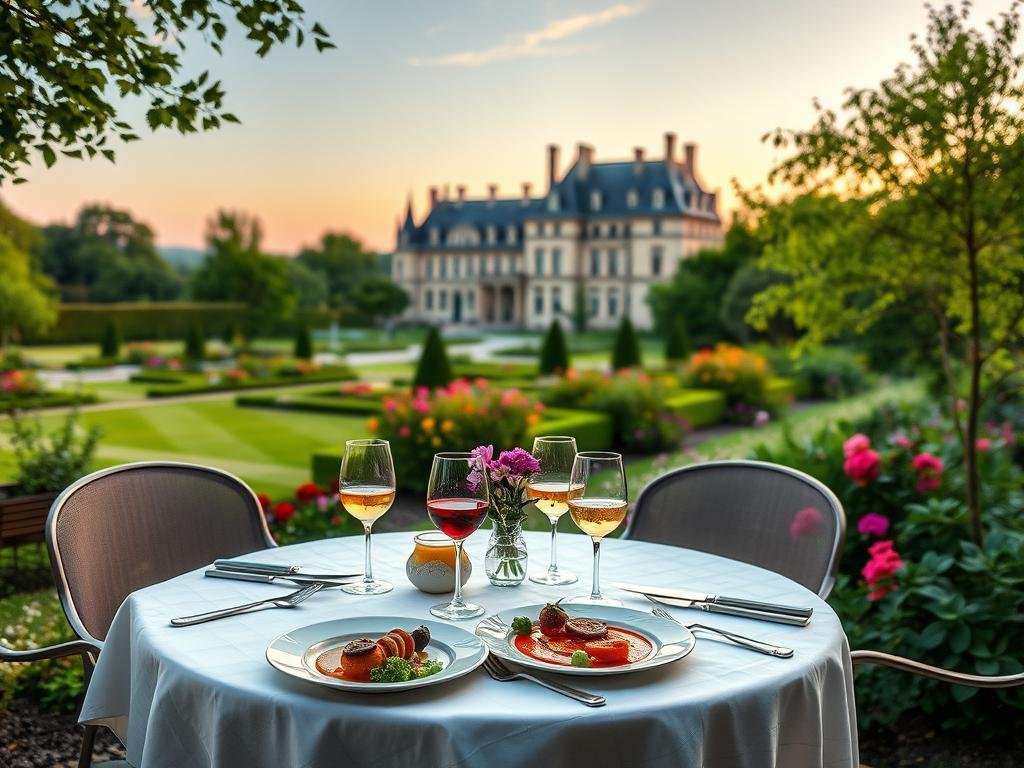
Local Specialties to Try
No visit to Château de Hautefort is complete without indulging in regional specialties. The area is renowned for its exquisite local French cuisine, featuring dishes that showcase the unique flavors and culinary techniques of the Dordogne. From the rich, earthy notes of foie gras and truffles available at the Excideuil market every Thursday and in premium markets during winter12, to the rustic charm of traditional Périgord recipes, each bite offers a connection to the region’s rich gastronomic heritage12.
While savoring these delicious offerings, visitors are treated to the picturesque settings of the region, enhancing their culinary delights experience13. Whether enjoying a meal at a countryside inn or a sophisticated restaurant, the culinary scene around Château de Hautefort provides the perfect complement to the captivating beauty of the château itself.
Cultural Significance
The Château de Hautefort, a cherished part of the Château de Hautefort heritage, stands as a symbol of France’s rich history and cultural elegance. This 17th-century château is renowned for its impressive facade and meticulously manicured gardens designed by André Le Nôtre14. Such intricate landscaping not only adds to the grandeur of the castle but also signifies its importance in French heritage.
Role in French Heritage
Château de Hautefort plays a pivotal role in the French heritage landscape. As part of the guided tours of the Dordogne region, it offers visitors an enriching experience and a serene, picturesque setting14. The knowledgeable guides provide valuable insights into the history and architecture of the château, further emphasizing its cultural significance14. Interestingly, the château attracts primarily French tourists, showcasing its strong national appeal over international interest15.
Contributions to Arts and Literature
The contributions to arts and literature stemming from Château de Hautefort are profound. The château serves as an inspiration for countless works and discussions, reflecting themes of history, beauty, and creativity. The artistic ambiance of the château makes it an ideal venue for various cultural events and festivals, enriching the local arts scene and drawing art enthusiasts from across the nation. Such activities highlight its enduring influence on both the artistic community and French literature, cementing its place as a beacon of cultural significance.
Accommodations
For those seeking accommodations near Hautefort, a variety of lodging options cater to different preferences, from modern comforts to historic charm. Whether you desire the elegance of luxurious hotels near Château de Hautefort or the distinctiveness of unique stays, the area has something for everyone.
Hotels and Lodging Options
Exploring the hotels near Château de Hautefort, visitors will find numerous sophisticated places to stay. The nearby properties offer amenities such as hot tubs, swimming pools, and bikes for hire, ensuring a comfortable and enjoyable experience. Notably, properties like Châteaux dans les Arbres, located in Beaumontois-en-Perigord, feature luxurious accommodations in six intricately designed mini-châteaux, built by treehouse expert Rémi Bècherel16. For ease of access, the closest airport is Bergerac Dordogne Périgord Airport, just a 30-minute drive away16.
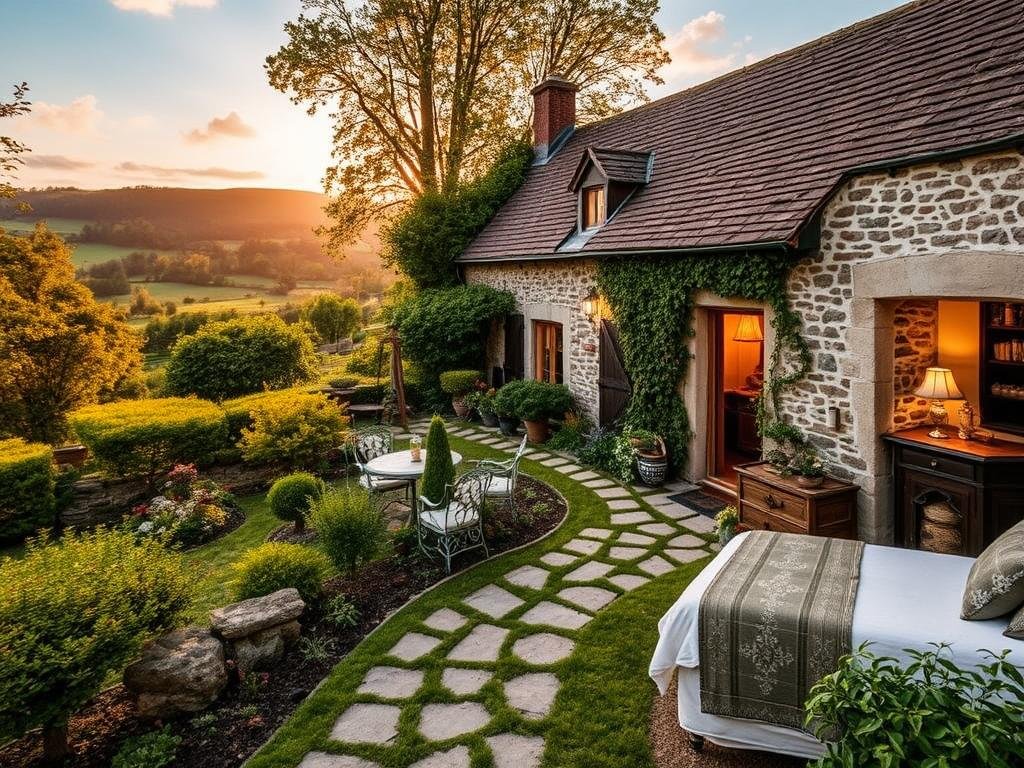
Unique Stays in the Area
For those seeking unique stays, Châteaux dans les Arbres offers an extraordinary experience. Each mini-château is equipped with double beds, private jacuzzis, and air conditioning, allowing guests to enjoy a blend of luxury and novelty16.
Regular dining options include local restaurant recommendations, along with the unique opportunity to have dinner delivered to your private château16. To finalize a booking, a 25% deposit is required, with full payment due 10 weeks in advance17. This ensures that your charming stay in accommodations near Hautefort is reserved well in advance.
Educational Programs
The educational programs at Hautefort offer a unique opportunity to delve into the rich history and architectural splendor of the famed French château. These programs are meticulously curated to provide an enriching experience for visitors of all ages.
Guided Tours for Schools
Château de Hautefort is committed to providing a comprehensive educational experience through its guided tours. Specially designed for schools, these guided tours ensure that students gain a deep understanding of the château’s significance. Our tours cater to small groups to maintain an intimate learning environment, capped at a maximum of 10 participants18. Through these immersive experiences, students are encouraged to explore history up close, guided by knowledgeable experts.
Workshops and Lectures
Our workshops at Château de Hautefort offer hands-on learning experiences that inspire creativity and intellectual curiosity. With a focus on various aspects of art and architecture, these workshops include practical sessions led by experienced instructors and artistic professionals. Students and participants are also invited to attend lectures that delve into the historical contexts and architectural details of the château19. These workshops and lectures are designed to stimulate innovative thinking and foster a deeper appreciation for heritage and the arts.
Local Community Involvement
Château de Hautefort prides itself on deep community involvement, fostering a sense of unity and shared purpose among residents and visitors alike.
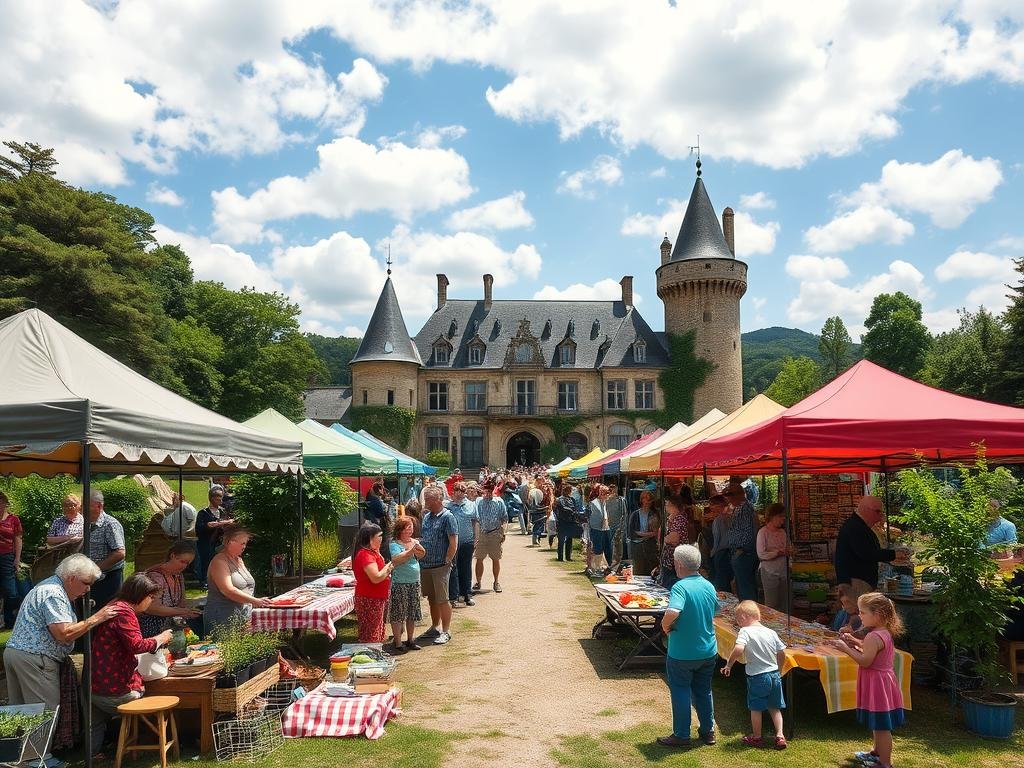
Partnerships with Local Organizations
The château has established robust partnerships with local organizations, promoting cultural and social events that benefit the entire community. For instance, the nearby towns host several enriching events such as the Ball of Illusions in Sarlat on August 20th and the Creations and Artisans Night Market in St Cyprien on August 21st20. Moreover, organizations like the Cour d’appel d’Agen support initiatives across multiple jurisdictions, including Gers, Lot, and Lot-et-Garonne, significantly contributing to the château’s regional reach21.
Volunteering Opportunities
Volunteering opportunities at Château de Hautefort are plentiful, offering locals the chance to actively participate in preserving and enhancing this historic site. Programs span from conservation efforts to participating in vibrant community events. For example, volunteer-led activities such as the Medieval Festival in Belves on August 10th and 11th, and the Egg Hunt in Sarlat on April 1st, engage numerous community members20. This integration of local residents into the château’s activities not only strengthens bonds but also ensures the preservation of the site for future generations.
Sustainable Practices
Château de Hautefort is dedicated to implementing a range of sustainable practices that align its historical significance with modern environmental responsibilities. By integrating innovative approaches, the château ensures that its legacy not only endures but thrives in an eco-friendly manner.
Conservation Efforts
The conservation efforts at Château de Hautefort are meticulously designed to maintain the château’s historical integrity while incorporating advanced techniques. This approach allows for the preservation of architectural and natural elements. For example, the château has embraced rainwater collection systems and organic gardening methods, similar to those used in the hanging garden at Château de Turenne22. These measures are essential in reducing water consumption and ensuring the grounds’ vitality.
Moreover, the surrounding region’s division into areas like the Green Périgord, which houses natural parks, highlights the broader commitment to sustainability in the region23. By working in concert with the local environment, Château de Hautefort exemplifies how heritage sites can champion conservation efforts.
Eco-Friendly Initiatives
The eco-friendly initiatives at Château de Hautefort extend beyond simple conservation measures. The château incorporates renewable energy sources and sustainable building materials in its maintenance and restoration projects. These initiatives aim to reduce the carbon footprint significantly and promote an environmentally conscious ethos.
In harmony with the architectural heritage of the Dordogne region, known as the Land of 1001 Castles23, the château’s sustainable practices ensure that it remains a beacon of eco-friendliness. By adopting these measures, Château de Hautefort not only preserves its majestic beauty but also inspires other heritage sites to follow suit, promoting a greener future for heritage tourism.
Frequently Asked Questions
The FAQs Château de Hautefort section serves as a helpful resource for visitors and history enthusiasts alike. Addressing common visitor inquiries and historical monument questions, this segment aims to prepare guests for a seamless and informative experience at this majestic château.
Visitor Inquiries
When planning your visit to Château de Hautefort, it’s essential to know the visiting hours and the best time to enjoy the meticulously maintained formal gardens designed by André Le Nôtre, celebrated for his work on the Palace of Versailles24. The château is accessible most of the year, with special events occurring during peak seasons. Accessibility options for differently-abled visitors are available, ensuring everyone can marvel at the unique blend of art and history housed within this 17th-century masterpiece.
Historical Questions
Château de Hautefort’s rich history often piques curiosity. Questions frequently arise about its architectural evolution and its significance in French heritage, echoing the expertise of landmarks like Beynac Castle and Castelnaud-la-Chapelle, both intricately tied to medieval and Renaissance periods24. Visitors and scholars also inquire about the restoration efforts that preserve its grandeur today, inspired by comprehensive preservation programs. The château stands not just as a historical monument but as an enduring testament to classical French artistry and dedication to heritage.
FAQ
What are the visiting hours for Château de Hautefort?
Is Château de Hautefort accessible for visitors with disabilities?
Can I bring my dog to Château de Hautefort?
Are guided tours available?
What should I wear when visiting Château de Hautefort?
Is photography allowed inside Château de Hautefort?
Are there restaurants or cafes on-site?
How can I book my tickets to visit Château de Hautefort?
What events take place at Château de Hautefort?
What nearby attractions complement a visit to Château de Hautefort?
Are there any unique accommodation options nearby?
What sustainability practices are implemented at Château de Hautefort?
Source Links
- Ophorus : Our selection of the most famous Dordogne Castles
- Château de Hautefort
- Discovering the castles of the Dordogne – La Maison de Léopold
- The architectural style of the Dordogne | French Plans
- Guide To Chateau de Hautefort In The Dordogne
- Discovering little-known castles in France
- The castles of Périgord Noir
- Visit the castles of Dordogne in Périgord
- Find the best activities in Dordogne – Périgord
- The Ultimate Guide to Visiting the Dordogne – Bon Traveler
- Travel advice – PerigordBlog
- What to Do –
- Ophorus : Our selection of the most famous Dordogne Castles
- Ophorus : Our selection of the most famous Dordogne Castles
- The other Dordogne: exploring France’s unspoiled Périgord region
- The magical Chateaux dans les Arbres (Castles in the trees) – Globetotting
- Hautefort Treehouse | Treehouse in Dordogne | Canopy & Stars
- 2025 Creative Awakening Retreat | Manor & Maker
- Painting Retreat with Johanna Spinks | Manor & Maker
- Our French Dream
- Annexes (Articles Annexe Tableau I à Annexe Tableau XVII)
- Château de Turenne and one of France’s Most Beautiful Villages Château de Turenne |
- Why does Périgord have 4 colors? (White, Purple, Green, Black)
- Ophorus : Our selection of the most famous Dordogne Castles
